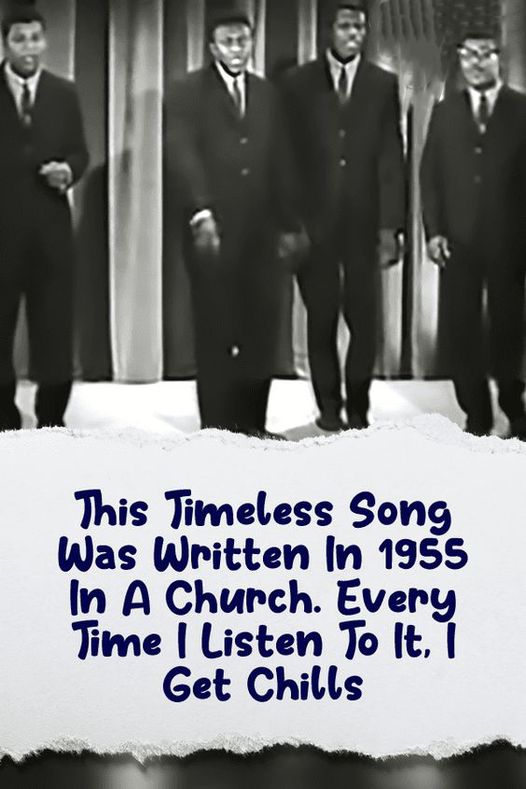Every generation has a song that somehow escapes time — a melody so pure and honest it feels like it’s always been here. “In the Still of the Night” is one of those songs. Written in 1955 by Fred Parris and recorded by his doo-wop group, The Five Satins, it remains one of the most hauntingly beautiful love songs ever written — a melody that still sends chills down the spine 70 years later.
Its magic lies not just in its tune, but in its story — one that began in the most unassuming place imaginable: a church basement in New Haven, Connecticut.
Born from Stillness
Fred Parris wasn’t a star when he wrote it. He wasn’t even famous locally. He was just a young man in love, aching with emotion and looking for a way to put it into words. The story goes that one quiet night in 1955, while sitting in the basement of St. Bernadette’s Church, he scribbled down the first lines of what would become a defining piece of American music history.
It wasn’t written for fame. It wasn’t written for charts. It was written for a girl — and for the feeling of holding someone close in the still, silent hours of the night, when time seems to stop and love feels infinite.
Parris later said he wanted to capture that fragile moment when affection feels eternal — when the world outside disappears, and all that matters is the person beside you. That emotional honesty is exactly what makes the song so enduring.
The Humble Beginning
When The Five Satins recorded “In the Still of the Night,” they didn’t have a fancy studio or big-budget production. They recorded it in the church basement with minimal equipment — just voices, a few instruments, and pure emotion.
Initially, the song didn’t set the world on fire. It was a modest regional hit, climbing to No. 24 on the national pop charts and No. 3 on the R&B charts in 1956. But even then, people could tell there was something different about it. Its harmonies were soft but confident, its rhythm steady but intimate, like a heartbeat.
As decades passed, that quiet beginning turned into something legendary.
A Song That Refused to Fade
“In the Still of the Night” never truly left the airwaves. While other doo-wop hits came and went, this one lingered — rediscovered generation after generation. By the 1970s, it had become a staple on oldies stations. In the 1980s, it roared back into pop culture thanks to the Dirty Dancing soundtrack.
That single placement reignited its magic for millions of new listeners. Suddenly, people too young to remember doo-wop were slow-dancing to it, humming its refrain, feeling the same quiet ache Parris wrote about three decades earlier.
The song’s placement in Dirty Dancing wasn’t just background noise — it carried emotional weight. It underscored themes of innocence, first love, and the fleeting sweetness of youth. The moment the first “Shoo-doo, shoo-bee-doo” plays, you’re transported. It’s nostalgia, romance, and longing — all condensed into three minutes of harmony.
Covered, Reimagined, Never Diminished
Few songs have inspired as many covers as “In the Still of the Night.” Each new version seems to bring out a different shade of its emotion.
In the 1990s, Boyz II Men gave it a smooth R&B revival, their lush harmonies paying homage to the original while introducing it to a new generation of soul fans. Debbie Gibson added her own pop touch, and countless jazz and indie artists have performed stripped-down renditions — each one testifying to the song’s eternal resonance.
Even after all those versions, nothing quite matches the warmth and vulnerability of the original. It’s imperfect, raw, and beautifully human — exactly as it was meant to be.
A Cultural Touchstone
The song has appeared in dozens of films and TV shows — The Irishman, The Buddy Holly Story, The Firm, The Sopranos — often used to underscore scenes of memory and melancholy. Filmmakers love it because it doesn’t just fill silence; it creates mood.
Its melody is tender but heavy with feeling, its harmonies nostalgic but ageless. You can’t hear it without remembering someone, somewhere — or imagining you do.
The song’s endurance was officially recognized in 2010 when Rolling Stone ranked it No. 90 on its list of the 500 Greatest Songs of All Time. For a tune written in a church basement by a man who just wanted to capture a feeling, that’s immortality.
Why It Still Resonates
So why does “In the Still of the Night” still move people after all these years? The answer might be its simplicity. It doesn’t try too hard. There’s no pretense, no overproduction, no bravado. Just longing. Just love. Just the sound of someone hoping that a perfect moment will last forever.
Its doo-wop rhythm mirrors the heartbeat — steady, patient, full of yearning. Its lyrics, simple as they are, reach something deep and universal: the fear of love slipping away and the desperate wish to hold on just a little longer.
You don’t need to have lived through the 1950s to understand it. You just need to have loved someone.
The Legacy of Stillness
Music critics often say the best songs don’t age — they evolve. “In the Still of the Night” proves that. It’s survived through vinyl, cassette, CD, and streaming, outliving the formats themselves. And no matter how technology changes, its emotion doesn’t.
The song isn’t just about romance anymore. It’s become a time capsule of human tenderness — a moment of quiet in a noisy world.
Today, when listeners discover it for the first time on YouTube or Spotify, they experience what millions before them did: that sudden hush, that soft ache, that deep recognition of something true.
A Love Letter That Never Ends
Fred Parris passed away in 2022, but his legacy remains. Every time the opening notes of “In the Still of the Night” echo through a room, his voice still carries — warm, vulnerable, timeless.
It’s hard to believe that something written in a church basement by a young man just trying to express what was in his heart would become one of the greatest love songs ever written. But maybe that’s exactly why it did.
Because “In the Still of the Night” reminds us of something we all forget — that great art doesn’t come from fame or money or luck. It comes from sincerity. From sitting in the quiet, with your heart open, and letting truth pour out.
So next time you hear that familiar refrain, close your eyes. Let it wash over you. Remember that love, like music, doesn’t need to shout to last forever. Sometimes, the most powerful moments are the ones whispered softly… in the still of the night.



